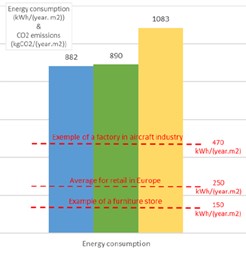Analyses & Studies • Publications
How to set up the Energy Baseline for your asset portfolio KPI?

What is an Energy Consumption Baseline?
A baseline serves as a point of reference or comparison for evaluating another value or situation. It allows us to determine whether the measured data is distinct, unusual, or requires special attention, or if it aligns closely with the baseline. By comparing against this reference point, we can assess the significance and characteristics of the data in question.
In sustainability for real estate, construction, or factories, we can use a baseline for energy consumption. It allows you to evaluate the energy performance of different assets of your portfolio and will help to make decisions in energy savings action. We’ll focus on the why and how the Energy baseline in this article, and some principles could apply to any other baseline setup.
Why do you need to set up an Energy Baseline?
To choose an energy baseline, you can either choose to base yourselves on reference values from the sector or choose to set it up from your own data. Why should you use this second choice?
a. Your assets may operate in special ways that would make it difficult to find relevant comparative data in the market, such as very specific types of retail shops, manufacturing processes, or hospitality resorts;
b. A significant portion of your assets’ energy consumption does not appear to align with any existing reference baselines in the market;
c. You would like to establish a baseline according to some indicators that are relevant to your sector and your brand. Examples of KPI would be lighting power density, screen power/sqm, process power/sqm, energy/number of rooms, or the number of occupied rooms…
d. Etc
Setting up your own baseline is also a good way to make your team involved in the calculation and own the baseline. Later on, they would be more involved in the energy savings action plan.
Setting up the Energy Baseline: How?
To set up the energy baseline, here is one methodology, as examples:
- Choose several assets that you think will represent your activities well and that encompass most of the various activities of your portfolio: this step might not be as easy as it seems;
- Energy data needs to be available, through energy recording and sub-meters ideally;
- Calculate the yearly consumption, by MWh/year of these several projects;
- Calculate and determine the baseline KPI such as yearly consumption by kWh/year.sqm of these several projects (or kWh/occupation or kWh/products, or any energy KPI that has been chosen with your energy consultant);
- You can then establish the baseline by calculating the mean or median value of all these assets.

The baseline established in this graph is according to 3 assets’ data and is around 900 kWh/sqm. yr
What's next?
After you have established the energy baseline, you can use it to evaluate your portfolio’s assets and to implement an action plan to save energy.
An in-depth Energy audit may be needed for some assets. Implementation of energy management standards such as ISO 50001 is helpful to continuously improve the energy baseline.
A baseline can be changed; it is not a fixed value. A new situation may involve updates in the baseline. For example, your assets may all have implemented Building Management System, CO2-sensor-controlled HVAC, very low Lighting Power Density, or daylight sensors, etc. It would be relevant to update the baseline after global modifications have been achieved.
TERAO can suggest different KPI and baseline calculations for your assets.
SOURCE: TERAO


